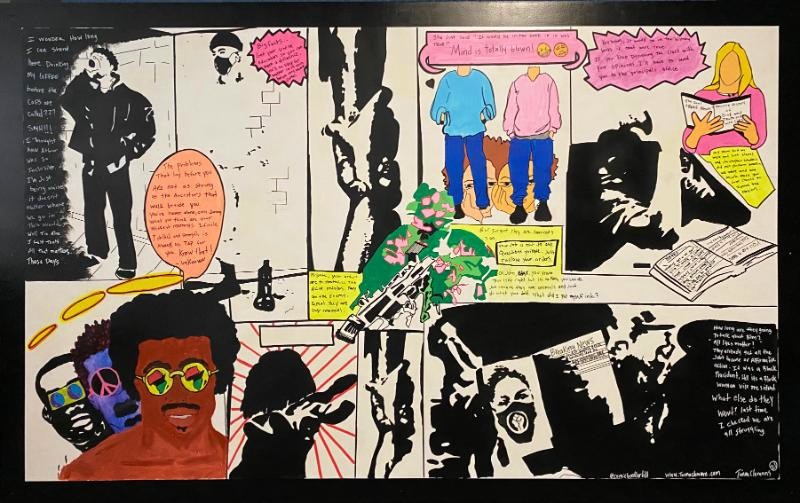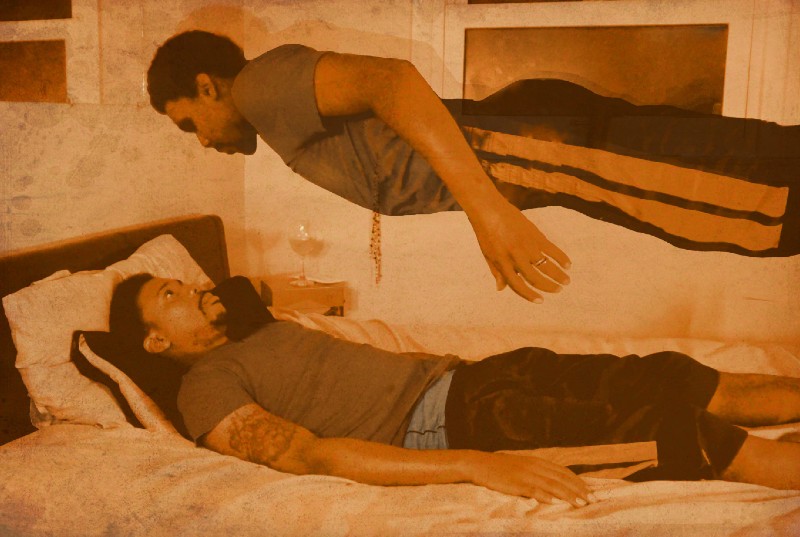Demario Dotson | AADL Black Lives Matter Muralist

Demario Dotson (b. 1994)
Sandra Blands With Capes (Protecting the Black Youth From the Police)
sbwithcapes.com
Instagram: @DemarioDotson
Following the Ann Arbor District Library's Call for Artists in 2020, AADL installed a Black Lives Matter mural on the south side of Library Lane on Friday, May 21 featuring the works of eight artists.
Below is our interview with muralist Demario Dotson.
Quadre Curry | AADL Black Lives Matter Muralist

Quadre Curry (b. 1997)
quadrecurry.com
Instagram: @reddq.art
Following the Ann Arbor District Library's Call for Artists in 2020, AADL installed a Black Lives Matter mural on the south side of Library Lane on Friday, May 21 featuring the works of eight artists.
Below is our interview with muralist Quadre Curry.
T'onna Clemons | AADL Black Lives Matter Muralist

T'onna Clemons (b. 1987)
tonnaclemons.com
Instagram: @comicbookartist
Following the Ann Arbor District Library's Call for Artists in 2020, AADL installed a Black Lives Matter mural on the south side of Library Lane on Friday, May 21 featuring the works of eight artists.
Below is our interview with muralist T'onna Clemons.
Ten works from "Please Stand By: The 2021 Stamps School Senior Exhibition" that show the collection's creative range

All 91 University of Michigan students featured in Please Stand By: The 2021 Stamps School Senior Exhibition deserve every ray of light that can cut through the darkness of the past 15 months.
You can be their sunshine and check out all the projects by the BA, BFA, and Interarts Performance students from the Stamps School's Integrative Project and Senior Studio over at stampsgrads.org.
But here are 10 pieces of art, animation, books, product designs, software, and songs that caught my eyes and ears as I perused the work of these fresh talents.
Riverside Arts Center’s "Present: An Online Exhibit" offers an egalitarian collection of creative endeavors

Art is essential, whether or not it is created for public display.
All art, whether fine art or craft, is worthy of representation.
Though these two statements seem straightforward, they might be considered controversial in the fine art universe.
Riverside Arts Center’s recent online exhibit, Present, pushes the boundaries of public art in online spaces by eliminating the jurying process and allowing anyone to submit artwork with the expectation that it will be placed in the show. The exhibit's homepage displays a gallery of thumbnail images with brief descriptions of the submissions, which range from regular exhibitors in the Ypsilanti and Ann Arbor area to crafts and Lego projects made among groups of family members. This egalitarian approach offers a fresh perspective on what it means to create art, who this art is for, and what value creativity has when the world no longer resembles the one we know.
Riverside Art Center’s call for submissions asks for work regardless of whether or not the creator is a working artist, and this cosmopolitan approach yielded eclectic results that give viewers a chance to see what creative projects community members have produced during an unprecedented time. The call for art reads:
"The Art of Queer Health Sciences" communicates empathy, not just data

We sat at a table outside Vinology just as a 50-degree cold rain picked up. It was strong enough to send a chill but not blowing sideways enough to chase off two people determined to do something outside of our house even in a less-than-ideal environment where gray was the primary color.
That's when a shock of green veins caught my eye in Vinology's window.
Then the blue-purple river, then yellow and orange and red dashes.
Small splashes of brightness in an otherwise dull landscape.
But it wasn't until I looked up Noelani Conahan's painting later that I learned about the research by Dr. Michelle Munro-Kramer that inspired it:
U-M alumnus William Weese donates considerable Chinese ceramics collection to UMMA

William Weese just dropped a whole lot of Chinese ceramics on the University of Michigan Museum of Art.
Thankfully, the folks at UMMA aren't as clumsy as this post's opening sentence, and the more than 1,000 ceramics and decorative arts donated by alumnus Weese are fully intact and greatly strengthen the museum's already renowned Asian art collection.
Weese's art donation is valued at $3.35 million and he kicked in another $1.7 million for an endowment covering education, research, and programming with the ceramics.
"I have been studying and collecting Chinese art and ceramics since the early 1980s—the craftsmanship and history of the works has fascinated me my entire life," Weese said in a story published by Michigan News.
The Weese collection is rich with pieces from the Ming and Qing dynasties, and select pieces will be on view in person at UMMA in fall 2021. But the museum has already put together an extensive, feature-rich website that can be viewed now.
Below are a few more images from the Weese collection:
WSG Gallery's "The World Turns With and Without People" and "Silence and Breezes" explore nature and, sometimes, humans

The artists at WSG Gallery are experts at creating impressive responses to themed prompts. For March's exhibit, Silences and Breezes, WSG artists created selections that range from action paintings influenced by music to calming and atmospheric representations of the natural world. April's theme is The World Turns With and Without People, but like March's show, many of the selected works seem to buzz with anticipation for warm weather.
WSG Gallery continues exhibiting virtually on its website—where past shows can also be seen—and in the 117 Gallery at Ann Arbor Art Center, which is where The World Turns With and Without People will be through May 3.
Inspired by Little Free Libraries, two miniature art galleries have popped up in Ann Arbor

Right: Some of the recent items at Take Art Leave Art. Photo by Shawn Bungo via Instagram.
The trend of placing a Little Free Library in front of your home/school/business and filling it with books is such a feel-good story—barren boxes or those filled with water-stained dregs from someone's basement notwithstanding—that it's surprising variations on this haven't happened: Canned Goods Rejected by Your Children Cupboard, Clothes That Your Kids Wore Once and Then Never Grabbed From the Bottom of Their Dresser Drawers Boutique, Sporting Goods I Thought I Could Sell for More Than I Was Offered Shoppe.
But Pittsfield Township's Shawn Bungo and Ann Arbor's Marie McMahon Parmer recently launched clever variations on the Little Library ideal by offering free art.
Yasmine Nasser Diaz's "For Your Eyes Only" invites viewers to wrestle with our public-private lives in the Digital Age

Over the course of the past year, art spaces have shifted from in-person to primarily online, marking an enormous—and sometimes challenging—shift in the experience of an exhibition. Though many galleries and museums have now reopened at least partially, one artist’s recent exhibit bypasses concerns about whether to invite bodies into enclosed spaces. In fact, artist Yasmine Nasser Diaz created a space that's intended to be viewed from outside. Her latest exhibition, For Your Eyes Only, featured in the University of Michigan Institute for the Humanities Gallery through April 16, questions the boundaries of public and private space through the inaccessible, room-sized installation, which can be viewed from the street outside the gallery.
With the weather warming, now might be a better time to visit the exhibit than when I first attended in mid-February, when I rushed over on opening day. I was eager to participate voyeuristically, as both someone who has avoided public and private spaces during the pandemic, and a fan of installations that mimic a now-foreign “normal life.”


































